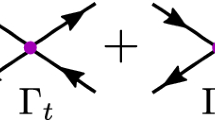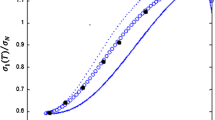Abstract
Using spatially inhomogeneous Éliashberg equations in the local-interaction limit, an exact solution of the problem of the superconducting transition temperature in a Ginzburg sandwich (a superconducting film coated with a dielectric layer containing Bose-type excitations, i.e., excitons) in the first order in a/L (where a is the interatomic distance and L is the film thickness) has been obtained. The result has been found to be independent of the exciton frequency. The excitonic mechanism appears only in second order in a/L since both components of the Cooper pair should enter a layer of thickness ∼a in order to interact through the exchange of excitons. Numerical estimates indicate that manifestations of the excitonic mechanism are practically undetectable in systems with L≫a. Calculations for the model with a narrow-gap and a wide-gap dielectric have been performed and compared to experimental data.
Similar content being viewed by others
References
V. L. Ginzburg, Zh. Éksp. Teor. Fiz. 47, 2318 (1964) [Sov. Phys. JETP 20, 1549 (1965)]; Phys. Lett. 13, 101 (1964).
High-Temperature Superconductivity, ed. by V. L. Ginzburg and D. A. Kirzhnits, Consultants Bureau, New York, 1982.
S. M. Durkin, J. E. Cunningham, M. E. Mochel, and C. P. Flynn, J. Phys. F 11, L223 (1981).
B. N. Belevtsev, Usp. Fiz. Nauk 160, 65 (1990) [Sov. Phys. Uspekhi 33, 36 (1990)].
V. L. Ginzburg and D. A. Kirzhnits, Zh. Éksp. Teor. Fiz. 46, 397 (1964) [Sov. Phys. JETP 19, 219 (1964)].
I. M. Suslov, Zh. Éksp. Teor. Fiz. 95, 949 (1989) [Sov. Phys. JETP 68, 546 (1989)].
I. M. Suslov, Sverkhprovodimist’: Fizika, Khimiya, Tekhnologiya 4, 2093 (1991).
Yu. A. Krotov and I. M. Suslov, Zh. Éksp. Teor. Fiz. 102, 670 (1992); 103, 1394 (1993); Physica C 213, 421 (1993); 245, 252 (1995).
Yu. A. Krotov and I. M. Suslov, Zh. Éksp. Teor. Fiz. 107, 512 (1995). [Sov. Phys. JETP 80, 275 (1995)].
A. A. Abrikosov, L. P. Gor’kov, and I. E. Dzyaloshinskii, Methods of Quantum Field Theory in Statistical Physics, Prentice-Hall, Englewood Cliffs, NJ, 1963.
P. G. De Gennes, Rev. Mod. Phys. 36, 225 (1964).
J. Ziman, Electrons and Phonons, Oxford University Press (1960).
A. A. Maradudin, E. W. Montroll, G. H. Weiss, and I. P. Ipatova, Theory of Lattice Dynamics in the Harmonic Approximation, Academic Press, New York-London (1971).
A. F. Orlov, A. K. Milai, and V. P. Dmitriev, Fiz. Tverd. Tela 18, 1470 (1976) [Sov. Phys. Solid State 18, 854 (1976)].
Author information
Authors and Affiliations
Additional information
Zh. Éksp. Teor. Fiz. 111, 717–729 (February 1997)
Rights and permissions
About this article
Cite this article
Krotov, Y.A., Suslov, I.M. Why have no manifestations of the excitonic mechanism been detected in Ginzburg sandwiches?. J. Exp. Theor. Phys. 84, 395–401 (1997). https://doi.org/10.1134/1.558129
Received:
Issue Date:
DOI: https://doi.org/10.1134/1.558129




